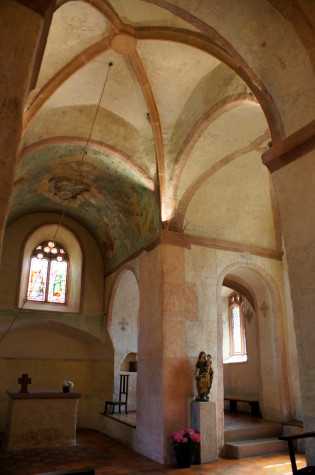Epfig
Chapel Sainte Marguerite
Away from the tourist stream, the little church Sainte Marguerite welcomes us with its contemplative simplicity and silence. Here, one immediately feels at home.
The Margaret Chapel is the result of two Romanesque building periods. The four arms of the building, which form a Latin cross, and the crossing tower date from the 11th century. The extension of the west wing forms a nave. The transept arms, crossing and choir are identical in size. It was not until the 12th century that the vestibule was added. The Gothic chapel in the southeast dates from the 16th century, the ossuary was built in the 19th century as an extension in front of the church on the old foundations.
In the herb garden, surrounded by Buch's kitchens, spices and medicinal herbs grow according to the model of earlier monastery gardens. In the middle - much to the delight of the birds - the water gushes out of a sandstone, symbol of eternal life.
The crossing tower with its rectangular openings and the twin windows below resembles the tower of Surbourg.
the simple interior of the church

In the choir window the holy Margaretha (with dragon) and the holy Barbara (with tower) shine.
The ceiling paintings depict Christ and symbols for the four evangelists.
Saint Barbara is the symbol of the beginning of life and Saint Margaret the symbol of the end of life..
The door beams and pillars from the Carolingian period have engravings in the herringbone pattern. The same can be found in the crypt of the Strasbourg cathedral (built in the 11th century).
Detail: herringbone pattern
The vestibule is also a mini cloister.
This is what it looks like inside the vestibule.
You can also conjure me away with the mouse!
The ossuary contains bones from the graves of Epfig and Kollwiler, the disappeared village east of Epfig, and from farmers who died in the Peasant War in 1525.
Photos: G. u. V. Eichinger, Mai 2011